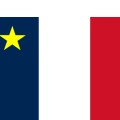"On the falling tide the freighted vessels departed, bearing a nation, with all its household gods, into exile, exile without an end". In his epic poem, Evangeline, Henry Wadsworth Longfellow relates the tragedy of lovers Evangeline and Gabriel who became separated during the 1755 Grand Derangement of the Acadians. This Acadian Romeo and Juliet remains popular in Nova Scotia.
Acadians' Catholic faith, a language that stems from their ancestral homeland of Poitou, France, and the experience of the mid-18th century expulsion still unite them today. The first permanent Acadian settlers arrived by ship from France in 1636 and lived a relatively undisturbed agrarian lifestyle, centred around the Bay of Fundy, for more than a hundred years. Unfortunately, their neutral stance in the military conflict between the English and the French led to the 1755 deportation. When the English were unable to force the Acadians to swear unconditional allegiance to the King of England, they began a campaign that banished some 9,000 men, women and children from their lands.
When the Acadians were allowed to resettle in their homeland in 1764, they found that others had settled on their lands, so they migrated to less fertile parts of Nova Scotia, Prince Edward Island and New Brunswick. Here, an archipelago of francophone communities formed an ethnic Acadie, a rural, family-oriented society whose heritage distinguishes them from other French Canadians and connects them with the scattered population of Acadian origins in Quebec, France and Louisiana.
The heart of Acadia today is in New Brunswick. Since 1961, the province's francophone community has grown by 16%, whereas it has fallen by 5% in Nova Scotia and 28% in Prince Edward Island. Census figures from 1996 indicate the mother tongue of a third of New Brunswickers is French, and 92% of those speak French at home. Canada's only officially bilingual province maintains educational systems for both language groups. Nearly half of New Brunswickers between the ages of 15 and 24 can speak both official languages, a rate that is higher than in any other province in Canada and double the national average.
In 1982, New Brunswick recognized individual bilingual rights, and in 1993 extended that to collective equal rights for francophone and anglophone communities. This has created a climate for Acadian lobby groups to promote the development of their communities and distinctiveness.
The Acadian culture has witnessed an awakening with such current popular groups as Barachois from Prince Edward Island and Grand Derangement from Nova Scotia. New Brunswick is the home of most Acadian literary figures. Antonine Maillet, creator of La Sagouine, made the francophone world aware of Acadian culture, while Hermenegilde Chiasson has been the region's foremost playwright and filmmaker. In recent years, the city of Moncton has become the heart of the Acadian arts scene, with a film festival, theatre company, artists' co-operative, art galleries and other cultural organizations. Many a rural home on the Maritime coast flies the distinctive Acadian flag. Its similarity to the French tricolour reminds Acadians of their roots, while its prominent yellow star recalls their patron saint, the Virgin Mary. The flag is particularly prominent around the August 15 Feast of the Assumption of Mary, the Acadian national holiday since 1881.

